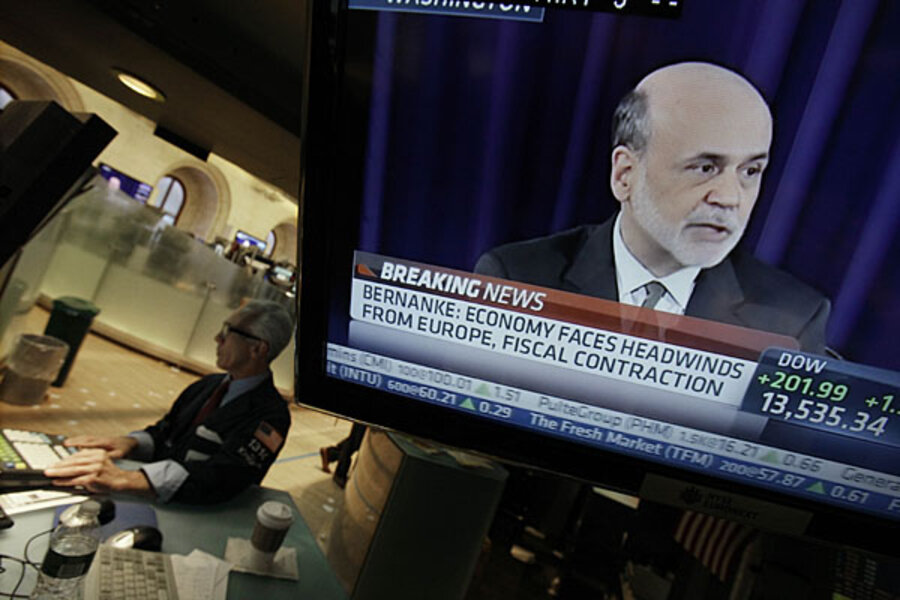Fed stimulus sends stocks soaring to 4-year high
| New York
The U.S. stock market staged a huge rally Thursday after investors got the aggressive economic help they wanted from the Federal Reserve.
The Dow Jones industrial average spiked more than 200 points and cleared 13,500 for the first time since the beginning of the Great Recession. The average is within 625 points of its all-time high.
The Fed said it would spend $40 billion a month, for as long as it takes, to stimulate the economy by buying mortgage securities — and perhaps buy more if the job market doesn't improve.
The central bank also extended its pledge of near-zero short-term interest rates into 2015, extended a program to drive down long-term rates and promised to maintain "highly accommodative" policy even after the economy strengthens.
It was the action that investors had been waiting for.
"They're saying that the punch bowl, the fuel for the economy, isn't going away — it's going to be here as long as you need it," said Tony Fratto, a former aide to President George W. Bush and managing partner at Hamilton Place Strategies, a policy consulting firm in Washington.
The Dow closed up 206.51 points, the seventh-biggest gain this year, at 13,539.86, its highest close since the last days of December 2007, the first month of the recession.
The broader Standard & Poor's 500 index was up 23.43 points at 1,459.99, also its highest since December 2007. The Nasdaq composite index, which has been trading at its highest levels since 2000, was up 41.52 at 3,155.83.
David Abuaf, chief investment officer at Hefty Wealth Partners, said he expects investors to keep shifting from safer assets like government bonds to stocks. That could push stock prices higher and start a cycle of increased wealth and spending.
"People will feel more confident, consumers will buy more goods, and GDP growth will increase," he said, referring to the gross domestic product, or economic output.
The stock market had already enjoyed a summer rally, in part because investors were betting on more Fed action. The Dow has climbed more than 1,100 points since the start of June.
Still, stocks spiked Thursday in industries across the economy. Materials companies, which tend to do well when the economy picks up, enjoyed the biggest gain — 2.6 percent as a group. Bank stocks also surged.
This is the third round of bond-buying by the Fed since the financial crisis struck in the fall of 2008. The goal is to lower long-term interest rates, get people to borrow and spend more and push investors into stocks.
If history is any guide, stocks could rally a bit more. In the three months following March 2009, when the Fed said it would expand its first round of buying, the S&P 500 rose 18 percent. In the three months after the central bank hinted at a second round of buying in August 2010, the S&P rose 14 percent.
Some economists and investors have warned that the bond-buying will have a limited impact because interest rates are already near record lows.
Critics of the stock rally note that the Fed is taking action because the U.S. economy is weak, and that economic growth in China is slowing and much of Europe is in recession and struggling with high debt.
Earlier this month, Mario Draghi, the head of the European Central Bank, said the central bank would buy the debt of countries that use the euro and are desperate to keep their borrowing costs down.
"I'm not buying anything," Gary Flam of Bel Air Investment Advisors said as Fed Chairman Ben Bernanke spoke at a press conference.
Flam added, referring to Draghi and Bernanke: "These two guys are propping up market in the hope it will trickle down to the economy, but after several years of this, we haven't seen a sustainable impact. The underlying problems of debt and deficits remain."
The Fed also lowered its outlook for economic growth this year to no stronger than 2 percent. That's down from its forecast of 2.4 percent in June.
In Treasury trading, the yield on the benchmark 10-year note fell slightly to 1.73 percent from 1.79 percent late Wednesday. It had spiked to 1.84 percent as investors sold bonds after the Fed announcement.
The dollar fell slightly against major currencies. It tumbled almost a penny against the euro, which rose to a hair under $1.30.
The price of gold climbed to its highest level since February — $1,772 an ounce, a gain of $38, or 2 percent. When the Fed buys bonds, gold often rises, both because investors fear inflation and because a weaker dollar makes gold more expensive.
The trading day didn't begin well. European markets were falling and U.S. futures slid, suggesting stocks might fall when U.S. markets opened.
When Bernanke started speaking, stocks shot up. A few minutes into his news conference, the Dow was up nearly 240 points.
In other news Thursday, the Labor Department reported that the number of people seeking unemployment benefits jumped last week to the highest level in two months, though the figures were skewed in part by Hurricane Isaac.
The government also said that wholesale prices rose 1.7 percent in August, the most in three years. They were driven up by higher costs for gas and food. Removing the impact of energy and food, however, the increase in prices has been mild.
Apple climbed $13.19, or 2 percent, to $682.98, a day after the company unveiled an iPhone with a bigger screen and faster download speeds.
The Fed action combined with the Middle East turmoil pushed crude prices up to above $98 a barrel of the first time in more than four months. Thursday. Oil rose $1.30 to close at $98.31 on the New York Mercantile Exchange.
Nearly four stocks rose for every one falling. Volume was high, 4.5 billion shares.





